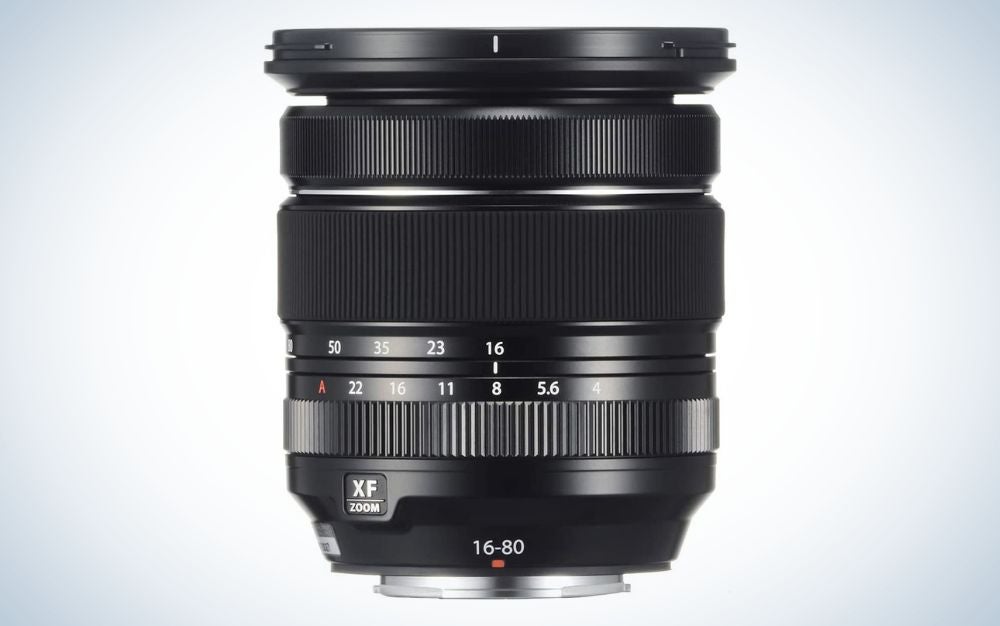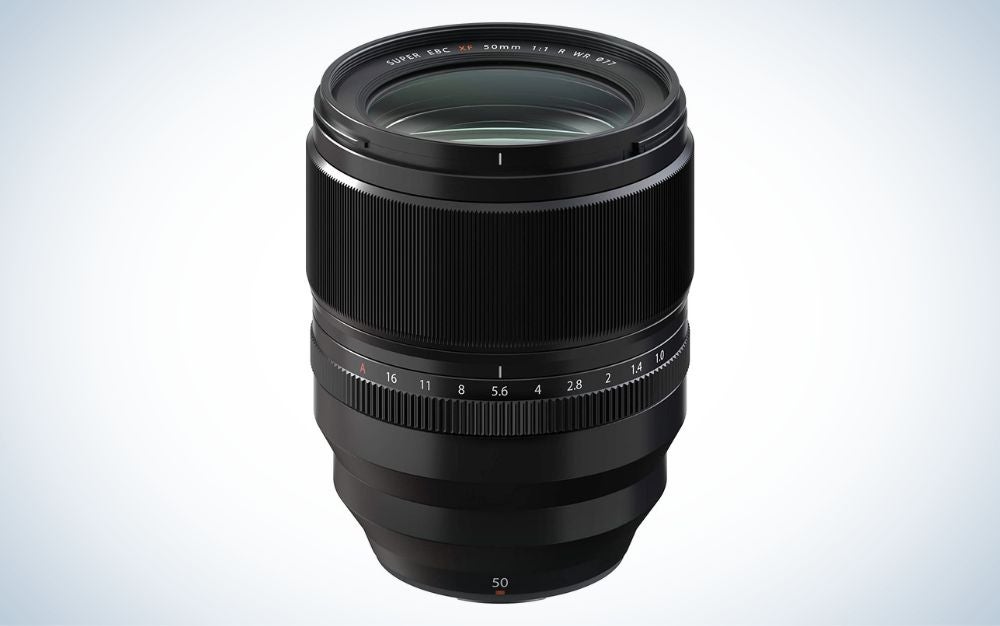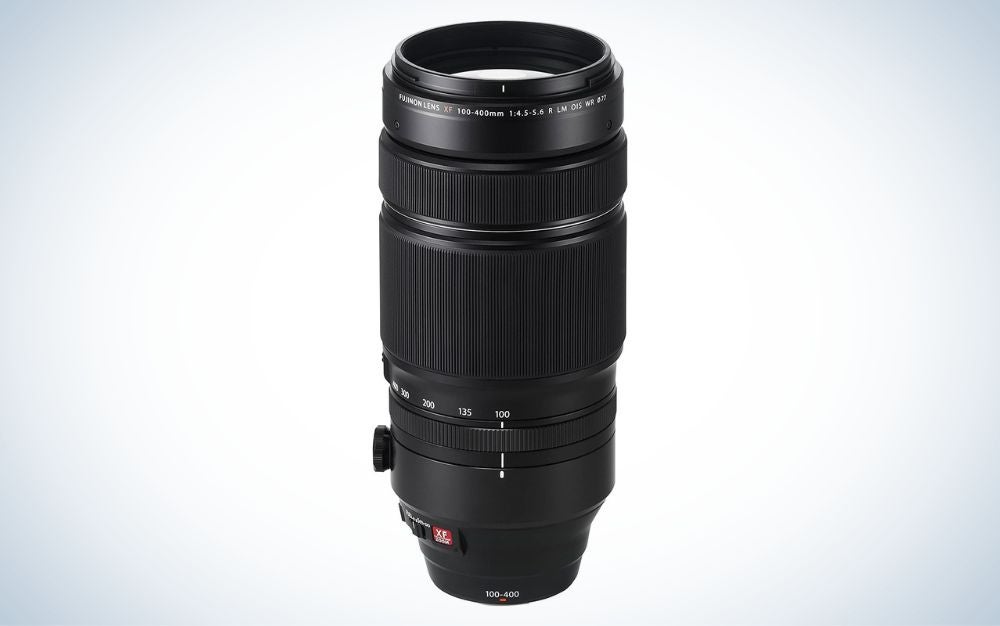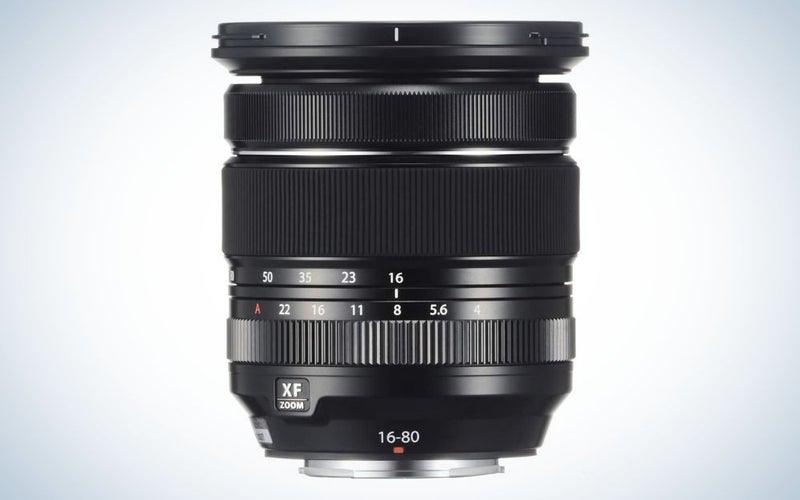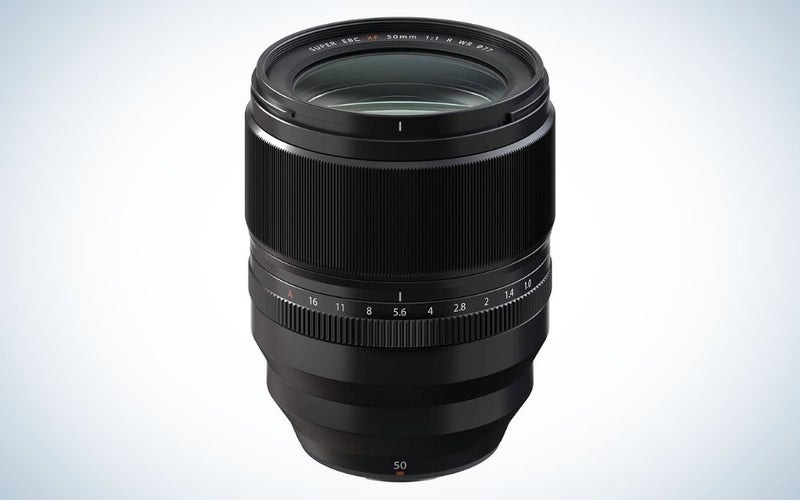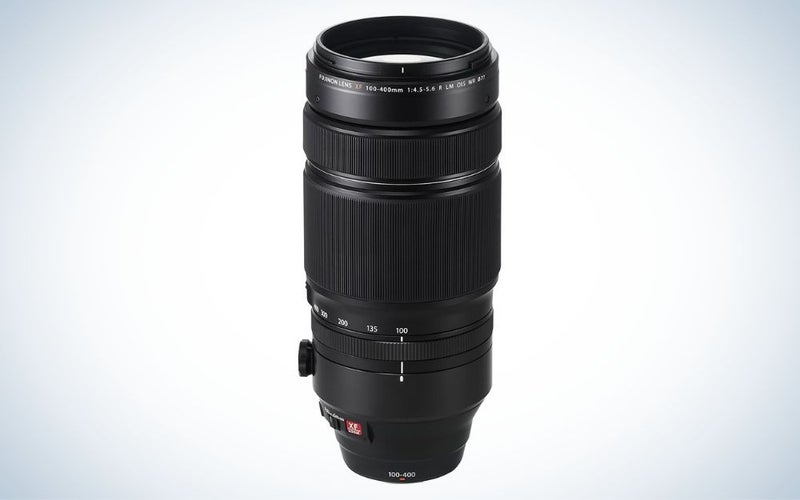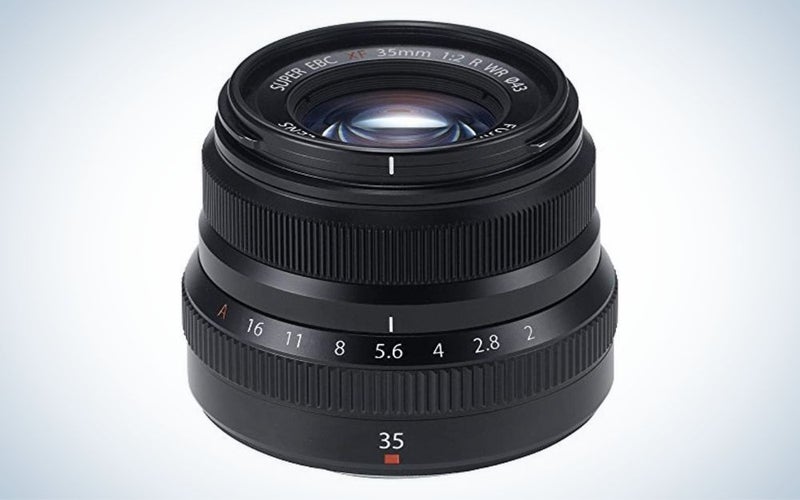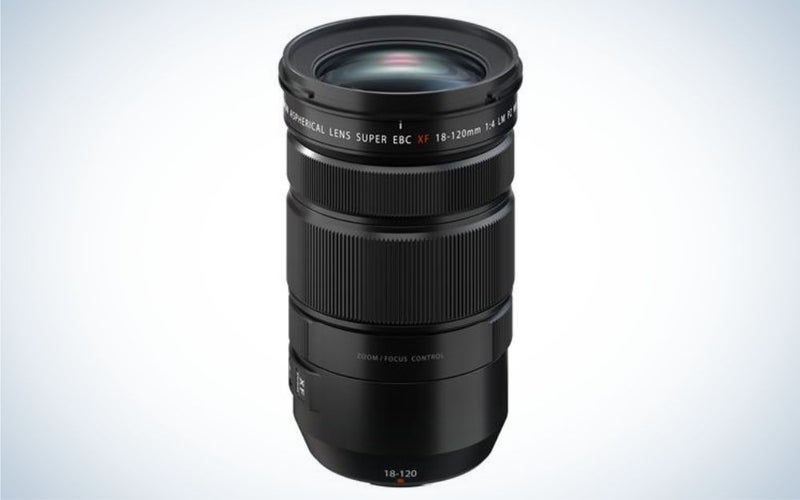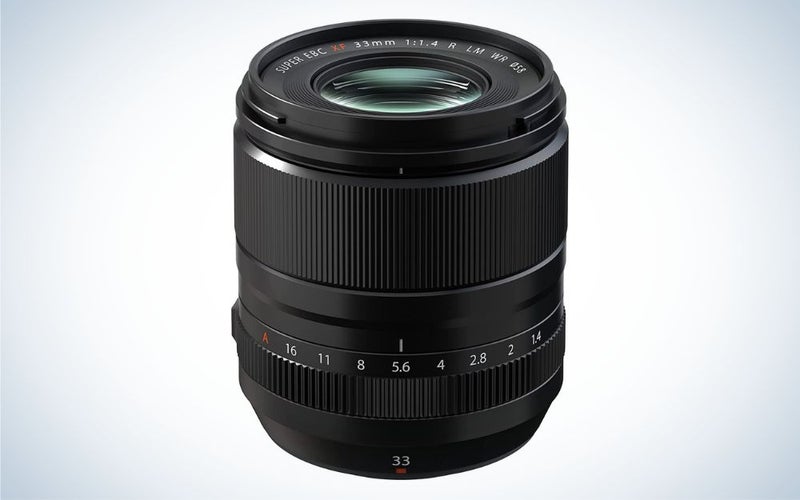
We may earn revenue from the products available on this page and participate in affiliate programs. Learn more ›
Fujifilm lenses often don’t get enough credit. The company’s excellent X-series mirrorless cameras soak up much of the spotlight with their rugged builds, compact designs, and unique X-trans sensors. But, the glass plays a huge role in what makes Fujifilm’s cameras so successful.
Look across the Fujifilm line, and you’ll find lenses for every possible photographic situation. That includes everything from fast sports action to fine art portraits. We’ve compiled this list of the best Fujifilm lenses to help you find the perfect model for your shooting style, creative vision, and budget.
- Best overall: XF16-80mm f/4 OIS WR
- Best for portraits: XF50mm f/1 R WR
- Best for sports: XF100-400mmF4.5-5.6 R LM OIS WR
- Best budget: XC35mm F2
- Best for video: XF18-120mmF4 LM PZ WR
- Best standard prime: XF33mmF1.4 R LM WR
How we picked the best Fujifilm lenses
To begin our search, we’ve restricted this list to Fujifilm’s X-series lenses. They’re compatible with any camera in the X-series lineup, including the X-T4 and the X-Pro3. Fujifilm also makes a line of medium format cameras and lenses in the GFX series, but those don’t play into this list.
I have been a camera writer and professional photographer for more than 15 years. During that time, I’ve reviewed or at least shot with the major cameras and lenses from all the popular manufacturers. I primarily shoot Fujifilm for my personal work.
To create this list, I relied on my own personal experience, editorial reviews, user feedback, and spec comparisons to find lenses that deliver performance that matches or exceeds their prices.
The best Fujifilm lenses: Reviews & recommendations
Best overall: XF 16-80mm f/4 OIS WR
Fujifilm
Why it made the cut: With a relatively fast aperture and a very versatile zoom range, this is truly a do-it-all lens that you may never need to take off of your camera.
Specs:
- Focal length: 16-80mm
- Mount: Fujifilm X
- Maximum aperture: f/4 (constant)
- Minimum focusing distance: 13.8 inches
- Dimensions: 3.1 x 3.5 inches
- Weight: 15.5 ounces
Pros:
- Extremely versatile zoom range
- Up to six stops of image stabilization
- Sharp
- Strong weatherproofing
- Relatively compact considering its range
Cons:
- The f/4 aperture isn’t f/2.8
Most zoom lenses with lots of range come with serious drawbacks like lackluster sharpness, slow variable apertures, and ample distortion. Fujifilm managed to avoid all of those with its do-it-all standard zoom. The Fujifilm X-series APS-C sensors give this the same angle of view you’d expect from a 24-120mm lens, which is wide enough for sweeping landscapes and plenty long for flattering portraits.
Its constant f/4 aperture isn’t quite as fast as some f/2.8 standard zooms, but Fujifilm’s lens offers up to six stops of image stabilization when combining optical IS in the lens and in-body stabilization from the camera. That enables hand-holding in plenty of situations without the need for a super-wide aperture.
As the WR in the name suggests, the lens is very weather resistant and will be right at home out in the elements. Despite its relatively wide range, it’s still fairly small and light. It weighs less than a pound. Compare that to a full-frame lens like the Canon 24-105mm f/4 IS II, and you’ll find that the Fujifilm is nearly a full pound lighter. That weight savings really comes into play when talking about a lens that stays on your camera at all times. This is a great lens for working pros or advanced amateurs who want a reliable, high-quality lens that will be comfortable in just about any shooting situation.
Best for portraits: XF50mm f/1 R WR
Fujifilm
Why it made the cut: This lens’s bokeh skills go beyond its impressive f/1 aperture.
Specs:
- Focal length: 50mm
- Mount: Fujifilm X
- Maximum aperture: f/1
- Minimum focusing distance: 28 inches
- Dimensions: 3.43 x 4.07″
- Weight: 1.86 pounds
Pros:
- Super-fast aperture
- Bokeh control
- Extremely sharp
- Ideal portrait focal length on an APS-C body
Cons:
- Big and heavy
- Nailing focus at f/1 is a specific skill
Just typing f/1 as a lens’s maximum aperture feels like a typo. Canon used to make a 50mm f/1 that debuted in 1989 but has since been discontinued. And Leica makes a 50mm f/1 that will cost you more than I paid for my car. Fujifilm’s 50mm f/1, however, is readily available, and it’s a portrait machine.
It’s sharp even when shooting wide open, which is an achievement in itself. The lens naturally vignettes at f/1 (how could it not?), but that mostly disappears by the time you get to f/2. As you stop down the lens, the bokeh gets more circular as well.
It’s a heavy lens for a prime, but that’s true of any fast telephoto lens. Because this one can open to f/1, however, it can create separation between a subject and its background even in relatively close quarters. That can come in very handy if you’re trying to shoot in a cluttered or distracting space. Because it’s a pro lens, it offers ample weatherproofing, so it’s truly built for work.
If you’re not ready to shell out the huge bucks for the f/1, I have also had really good experiences with the 56mm f/1.2. It doesn’t quite have the wow factor you get with the f/1, but it’s smaller, lighter, cheaper, and still churns out excellent image quality.
Best for sports: XF100-400mm f/4.5-5.6 R LM OIS WR
Fujifilm
Why it made the cut: It feels like a full-frame 70-200mm, but it offers way more reach when shooting outdoor sports.
Specs:
- Focal length: 100-400mm
- Mount: Fujifilm X
- Maximum aperture: f/4-5.6
- Minimum focusing distance: 69 inches
- Dimensions: 11.4 x 7.7 x 5.2 inches
- Weight: 4.2 pounds
Pros:
- Extremely sharp
- Relatively compact considering its reach
- Five stops of image stabilization
- Fluorine coating resists grime and fingerprints on the large front element
Cons:
- Expensive
- May be too slow for some indoor sports situations
If you’re switching from a full-frame system, you might be surprised to find how similar this 100-400mm lens feels to a typical fast 70-200mm lens. Fujifilm’s glass cannon acts like a 150-600mm lens on a full-frame body, which is plenty of reach for just about any sports scenario. I’ve also used it for birding and wildlife photography, and it’s excellent.
If you’re an aperture snob, the f/4-5.6 variable maximum might sound too slow for you, but at these focal lengths, you don’t need a huge aperture to get blurry backgrounds and good separation between your subject and their environment. In fact, sometimes, the slightly smaller aperture comes in handy because it provides a little extra depth of field to encompass fast-moving subjects.
Hand holding a lens this long can be tricky, but the image stabilization system can provide up to five stops of IS when combined with a compatible camera. It comes with a hood and a tripod collar, so it’s easy to mount and keep steady out in the field if you don’t trust your hands not to shake. It’s overall an extremely versatile lens with tons of applications.
Best budget: XC35mmF2
Fujifilm
Why it made the cut: Everyone should have a cheap standard prime for simple shooting.
Specs:
- Focal length: 35mm
- Mount: Fujifilm X
- Maximum aperture: f/2
- Minimum focusing distance: 13.7 inches
- Dimensions: 2.3 x 1.83 inches
- Weight: 4.59 ounces
Pros:
- Cheap
- Small
- Light
- Useful normal focal range
- Sharp beyond its price tag
Cons:
- Lackluster weather sealing
- No physical aperture ring
This is Fujifilm’s answer to the nifty 50, a cheap standard lens with a relatively fast aperture and image performance that punches above its weight. It weighs just over four ounces, which feels very balanced on smaller Fujifilm bodies like the compact XE series.
You won’t find much in the way of weather sealing, but at this low price point, you don’t have to worry too much about abusing it. It vignettes when shooting wide open, but that’s often appealing on a lens like this. Stop it down a bit, and the vignetting fades as the sharpness increases.
I particularly like this lens on one of the X-Pro bodies due to the rangefinder-like form factor.
Best for video: XF18-120mmF4 LM PZ WR
Fujifilm
Why it made the cut: Video-specific features like a stepless aperture ring and controlled lens breathing make this ideal for shooting motion.
Specs:
- Focal length: 18-120mm
- Mount: Fujifilm X
- Maximum aperture: f/4
- Minimum focusing distance: 24 inches
- Dimensions: 4.8 x 3 inches
- Weight: 1 pound
Pros:
- Smooth focusing
- Stepless aperture ring
- Very little lens breathing
- Nicely balanced
Cons:
- Expensive if you’re not shooting that much video
You can shoot video with just about any lens, but some offer specific features that make your footage look much better. Fujifilm’s 18-120mm zoom offers near-silent zooming and focusing, which comes in handy when you’re trying not to screw up your audio.
Fujifilm has gone to great lengths to prevent lens breathing, a phenomenon in which the lens’s field of view changes as you focus. You may not notice it shooting stills, but it can be very distracting to see the frame shift during focusing when you’re shooting video.
The stepless aperture ring is also something video shooters tend to prefer. If you’re only shooting occasional video, you’re probably better off with something like our best overall pick.
Best standard prime: XF33mmf1.4 R LM WR
Fujifilm
Why it made the cut: If you’re ready to upgrade from a basic prime, this model adds weatherproofing, burlier construction, and drastically improved image quality.
Specs:
- Focal length: 33mm
- Mount: Fujifilm X
- Maximum aperture: f/1.4
- Minimum focusing distance: 11.8 inches
- Dimensions: 2.7 x 2.9 inches
- Weight: 12.7 ounces
Pros:
- Exceptional image quality
- Combats issues like coma and fringing
- Compact
- Sharp even wide open
- Weather resistant
Cons:
- Expensive
If you’re dedicated to a standard prime lens (like I am), then you’ll want the best possible imaging performance. This lens provides essentially the same angle of view you’d expect from a 50mm lens on a full-frame camera. This isn’t a simple lens, however. There are 15 elements spread across 10 groups inside the barrel. All that glass does an excellent job of reducing unwanted effects like coma (which affects points of light in the frame) and color fringing.
This is one of Fujifilm’s pro-grade lenses, so it’s built to withstand harsh environments, including freezing temperatures, precipitation, and even dust. Despite its burly build, the lens weighs well under a pound and remains remarkably compact, so it balances nicely with bodies like the X-Pro3 and the X-T4.
It isn’t a cheap prime, but it is one of Fujfilm’s sharpest and best-looking lenses. As tough as it is, it will likely last for years if properly cared for.
Things to consider when shopping for the best Fujifilm lenses
Prime vs. zoom
Zoom lenses offer an undeniable level of convenience compared to their fixed focal length competition. With a zoom, you can stand in one spot and capture a subject in a variety of different ways. That convenience typically comes at a cost, though. Trade-offs include slower maximum apertures, larger lenses, and reduced overall image quality compared to primes. There are still plenty of zooms that dish out excellent image quality worthy of pro work.
While primes do have some advantages, they can also be limiting. Some photographers say you can simply “zoom with your feet,” but if you’re trying to photograph something over water or in the air, you can’t exactly zoom up into the sky to capture it.
Both types of lenses have their advantages and disadvantages, so you’ll likely want a mix as you build out your kit.
Focal length
The focal length of your lens determines the angle of view it provides. Shorter focal lengths provide wider angles of view. If you’re coming from a full-frame system, Fujifilm’s APS-C sensors complicate the focal length math a bit. Because the sensor creates a roughly 1.5x crop factor, a 24mm lens will give you the same angle of view that a 36mm lens would provide on a full-frame camera. In other words, the image will appear more zoomed in.
So, if you see a zoom range or focal length as it pertains to a Fujifilm X lens, it will actually feel longer than the number indicates.
As for choosing the focal length that’s right for you, it’s a very personal choice. I personally like a standard focal length like a 50mm prime (or a 33mm prime in the case of an APS-C sensor). Portrait photographers gravitate toward short telephoto focal lengths, while landscape photographers often rely on wide lenses. Everyone’s shooting requirements are different, but you want to be sure you know what focal length you’re looking for before making a purchase.
Weather resistance
Fujifilm’s pro-grade lenses offer some of the best weather-proofing and ruggedization you’ll find. Lenses with WR in the name offer exceptional protection against the elements. In fact, Fujifilm often shows its lenses covered in water drops as part of its marketing material.
If you’re using a more consumer-oriented body like the XE series, a WR lens will far exceed the weatherproofing found on the camera itself. So it may not be worth the expenditure since the camera isn’t meant for use in the elements even if the lens is.
Image stabilization
While most Fujifilm cameras offer in-body image stabilization, optical stabilization in the lens can greatly augment its overall effectiveness. OIS lenses work in concert with a camera’s internal stabilization system, which can push performance up to five or even six stops of shake reduction. This is particularly important on longer lenses or lenses you plan to shoot in the dark because it’s tricky to hold the camera steady.
Video features
Some Fujifilm lenses like the XF18-120mmF4 LM PZ WR offer video-specific features like de-clicked control rings and controlled lens breathing. These features are very useful for shooting video but may not be necessary if you’re primarily shooting stills.
FAQs
Q: How much do Fujifilm lenses cost?
Lenses like the XC 35mm lens can cost as little as $200, but higher-end models like the telephoto zooms go up to $2,000. You’ll find that many of the excellent primes fall under $1,000, which is cheaper than many full-frame systems.
Q: How long do Fujifilm lenses last?
I have personally owned a few Fujifilm lenses, like the 23mm f/1.4 WR prime, for more than five years, and they’re still going very strong. The XF lenses will last longer than the XC lenses, especially under heavy use, due to their metal construction and better weather sealing.
Q: What is the difference between Fujifilm XF and XC lenses?
XF represents Fujifilm’s more pro-oriented lenses. They offer metal barrels and lens mounts, as well as superior weather sealing. The XF lenses also typically provide the best possible image quality. XC lenses are geared more toward consumers and still offer excellent performance, but typically rely on more plastic construction and won’t fare as well in the elements.
Q: Can you buy refurbished Fujifilm lenses?
You can! Fujifilm offers refurbished lenses on its own. You can also buy them used from just about anywhere you’d expect to find high-end photo gear.
Final thoughts about the best Fujifilm lenses
Fujifilm doesn’t get enough credit for just how good its lenses are. It offers some of the sharpest, brightest, and most beautiful glass across any system. The lenses are also often more compact than their competition and offer excellent tactile features like physical aperture rings. The lenses represent a major selling point for jumping into Fujifilm’s system.
The post The best Fujifilm lenses in 2023 appeared first on Popular Photography.
Articles may contain affiliate links which enable us to share in the revenue of any purchases made.
